Overview
A rash is a noticeable change in the texture or color of your skin. Your skin may become scaly, bumpy, itchy, or otherwise irritated.
Different types of rashes
There are many different causes for rashes. Here’s a list of 21 with pictures.
Warning: graphic images ahead.
Flea bites
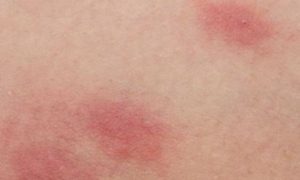
- usually located in clusters on the lower legs and feet
- itchy, red bump surrounded by a red halo
- symptoms begin immediately after being bitten
Fifth disease
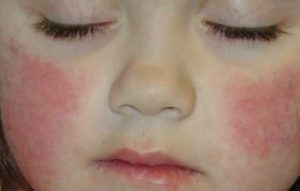
- headache, fatigue, low fever, sore throat, runny nose, diarrhea, and nausea
- children are more likely than adults to experience a rash
- round, bright red rash on the cheeks
- lacy-patterned rash on the arms, legs, and upper body that might be more visible after a hot shower or bath
Rosacea
- chronic skin disease that goes through cycles of fading and relapse
- relapses may be triggered by spicy foods, alcoholic beverages, sunlight, stress, and the intestinal bacteria Helicobacter pylori
- the four subtypes of rosacea encompass a wide variety of symptoms
- common symptoms include facial flushing, raised, red bumps, facial redness, skin dryness, and skin sensitivity
Impetigo
- common in babies and children
- often located in the area around the mouth, chin, and nose
- irritating rash and fluid-filled blisters that pop easily and form a honey-colored crust
Ringworm
- circular-shaped scaly rashes with raised border
- skin in the middle of the ring appears clear and healthy, and the edges of the ring may spread outward
- itchy
Contact dermatitis
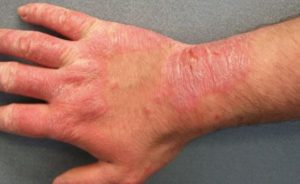
- appears hours to days after contact with an allergen
- has visible borders and appears where your skin touched the irritating substance
- skin is itchy, red, scaly, or raw
- blisters that weep, ooze, or become crusty
Allergic eczema
- may resemble a burn
- often found on hands and forearms
- skin is itchy, red, scaly, or raw
- blisters that weep, ooze, or become crusty
Hand, foot, and mouth disease
- usually affects children under age 5
- painful, red blisters in the mouth and on the tongue and gums
- flat or raised red spots located on the palms of the hand and soles of the feet
- spots may also appear on the buttocks or genital area
Diaper rash
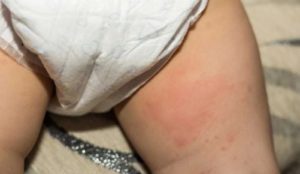
- located on areas that have contact with a diaper
- skin looks red, wet, and irritated
- warm to the touch
Eczema
- yellow or white scaly patches that flake off
- affected areas may be red, itchy, greasy, or oily
- hair loss may occur in the area with the rash
Psoriasis
- scaly, silvery, sharply defined skin patches
- commonly located on the scalp, elbows, knees, and lower back
- may be itchy or asymptomatic
Chickenpox

- clusters of itchy, red, fluid-filled blisters in various stages of healing all over the body
- rash is accompanied by fever, body aches, sore throat, and loss of appetite
- remains contagious until all blisters have crusted over
Systemic lupus erythematosus (SLE)
- an autoimmune disease that displays a wide variety of symptoms that affect many different body systems and organs
- a wide array of skin and mucous membrane symptoms that range from rashes to ulcers
- classic butterfly-shaped face rash that crosses from cheek to cheek over the nose
- rashes may appear or get worse with sun exposure
Shingles

- very painful rash that may burn, tingle, or itch, even if there are no blisters present
- clusters of fluid-filled blisters that break easily and weep fluid
- rash emerges in a linear stripe pattern that appears most commonly on the torso, but may occur on other parts of the body, including the face
- may be accompanied by low fever, chills, headache, or fatigue
Cellulitis
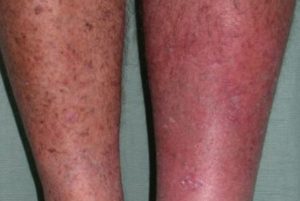
This condition is considered a medical emergency. Urgent care may be required.
- caused by bacteria or fungi entering through a crack or cut in the skin
- red, painful, swollen skin with or without oozing that spreads quickly
- hot and tender to the touch
- fever, chills, and red streaking from the rash might be a sign of serious infection requiring medical attention
Drug allergy
This condition is considered a medical emergency. Urgent care may be required.
- mild, itchy, red rash may occur days to weeks after taking a drug
- severe drug allergies can be life-threatening and symptoms include hives, racing heart, swelling, itching, and difficulty breathing
- other symptoms include fever, stomach upset, and tiny purple or red dots on the skin
Scabies
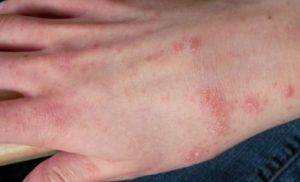
- symptoms may take four to six weeks to appear
- extremely itchy rash may be pimply, made up of tiny blisters, or scaly
- raised, white, or flesh-toned lines
Measles
- symptoms include fever, sore throat, red, watery eyes, loss of appetite, cough, and runny nose
- red rash spreads from the face down the body three to five days after first symptoms appear
- tiny red spots with blue-white centers appear inside the mouth
Tick bite
- pain or swelling at the bite area
- rash, burning sensation, blisters, or difficulty breathing
- the tick often remains attached to the skin for a long time
- bites rarely appear in groups
Seborrheic eczema
- yellow or white scaly patches that flake off
- affected areas may be red, itchy, greasy, or oily
- hair loss may occur in the rash area
Scarlet fever

- occurs at the same time as or right after a strep throat infection
- red skin rash all over the body (but not the hands and feet)
- rash is made up of tiny bumps that make it feel like “sandpaper”
- bright red tongue
Kawasaki disease
Share onThis condition is considered a medical emergency. Urgent care may be required.
- usually affects children under age 5
- red, swollen tongue (strawberry tongue), high fever, swollen, red palms and soles of the feet, swollen lymph nodes, bloodshot eyes
- may cause severe heart problems so consult a doctor if there’s concern
- however, usually gets better on its own
What causes rashes?
Contact dermatitis
Contact dermatitis is one of the most common causes of rashes. This type of rash occurs when the skin comes into direct contact with a foreign substance that causes an adverse reaction, leading to a rash. The resulting rash may be itchy, red, or inflamed. Possible causes of contact dermatitis include:
- beauty products, soaps, and laundry detergent
- dyes in clothing
- coming into contact with chemicals in rubber, elastic, or latex
- touching poisonous plants, such as poison oak, poison ivy, or poison sumac
Medications
Taking medications may also cause rashes. They can form as a result of:
- an allergic reaction to the medication
- a side effect of the medication
- photosensitivity to the medication
Other causes
Other possible causes of rashes include the following:
- A rash can sometimes develop in the area of a bug bite, such as a flea bite. Tick bites are of particular concern because they can transmit disease.
- Eczema, or atopic dermatitis, is a rash that primarily occurs in people with asthma or allergies. The rash is often reddish and itchy with a scaly texture.
- Psoriasis is a common skin condition that can cause a scaly, itchy, red rash to form along the scalp, elbows, and joints.
- Seborrheic eczema is a type of eczema that most often affects the scalp and causes redness, scaly patches, and dandruff. It can also occur on the ears, mouth, or nose. When babies have it, it’s known as crib cap.
- Lupus erythematosus is an autoimmune disease that triggers a rash on the cheeks and nose. This rash is known as a “butterfly,” or malar, rash.
- Rosacea is a chronic skin condition of unknown cause. There are several types of rosacea, but all are characterized by redness and rash on the face.
- Ringworm is a fungal infection that causes a distinctive ring-shaped rash. The same fungus that causes ringworm of the body and the scalp also causes jock itch and athlete’s foot.
- Diaper rash is a common skin irritation in infants and toddlers. It’s usually caused by sitting too long in a dirty diaper.
- Scabies is an infestation by tiny mites that live on and burrow into your skin. It causes a bumpy, itchy rash.
- Cellulitis is a bacterial infection of the skin. It usually appears as a red, swollen area that is painful and tender to the touch. If left untreated, the infection causing the cellulitis can spread and become life-threatening.
Causes of rashes in children
Children are particularly prone to rashes that develop as a result of illnesses, such as:
- Chickenpox is a virus characterized by red, itchy blisters that form all over the body.
- Measles is a viral respiratory infection that causes a widespread rash consisting of itchy, red bumps.
- Scarlet fever is an infection due to group A Streptococcus bacteria that produces a toxin causing a bright red sandpaper-like rash.
- Hand, foot, and mouth disease is a viral infection that can cause red lesions on the mouth and a rash on the hands and feet.
- Fifth disease is a viral infection that causes a red, flat rash on the cheeks, upper arms, and legs.
- Kawasaki disease is a rare but serious illness that triggers a rash and fever in the early stages and can lead to an aneurysm of the coronary artery as a complication.
- Impetigo is a contagious bacterial infection that causes an itchy, crusty rash, and yellow, fluid-filled sores on the face, neck, and hands.
You can treat most contact rashes, but it depends on the cause. Follow these guidelines to help ease discomfort and speed up the healing process:
- Use mild, gentle cleansers instead of scented bar soaps.
- Use warm water instead of hot water for washing your skin and hair.
- Pat the rash dry instead of rubbing it.
- Let the rash breathe. If it’s possible, avoid covering it with clothing.
- Stop using new cosmetics or lotions that may have triggered the rash.
- Apply unscented moisturizing lotion to areas affected by eczema.
- Avoid scratching the rash because doing so can make it worse and could lead to infection.
- Apply an over-the-counter hydrocortisone cream to the affected area if the rash is very itchy and causing discomfort. Calamine lotion can also help relieve rashes from chickenpox, poison ivy, or poison oak.
- Take an oatmeal bath. This can soothe the itchiness associated with rashes from eczema or psoriasis. Here’s how to make an oatmeal bath.
- Wash your hair and scalp regularly with dandruff shampoo if you have dandruff along with a rash. Medicated dandruff shampoo is commonly available at drugstores, but your doctor can prescribe stronger types if you need them.
Over-the-counter medications
Take acetaminophen (Tylenol) or ibuprofen (Advil) in moderation for mild pain associated with the rash. Talk to your healthcare provider before you start taking these drugs, and avoid taking them for an extended period because they can have side effects. Ask your healthcare provider how long it’s safe for you to take them. You may not be able to take them if you have liver or kidney disease or a history of stomach ulcers.
When to see your healthcare provider about rashes
Call your healthcare provider if the rash doesn’t go away with home treatments. You should also contact them if you’re experiencing other symptoms in addition to your rash and suspect you have an illness. If you don’t already have a physician, you can use the Healthline FindCare tool to find a provider near you.
Go to the hospital immediately if you experience a rash along with any of the following symptoms:
- increasing pain or discoloration in the rash area
- tightness or itchiness in the throat
- difficulty breathing
- swelling of the face or extremities
- fever of 100.4°F (38°C) or higher
- confusion
- dizziness
- severe head or neck pain
- repeated vomiting or diarrhea
Contact your healthcare provider if you have a rash as well as other systemic symptoms including:
- joint pain
- a sore throat
- a fever slightly above 100.4°F (38°C)
- red streaks or tender areas near the rash
- a recent tick bite or animal bite
What to expect during your appointment
Your healthcare provider will perform a physical exam and inspect your rash. Expect to answer questions about your:
- rash
- medical history
- diet
- recent use of products or medications
- hygiene
Your healthcare provider may also:
- take your temperature
- order tests, such as an allergy test or complete blood count
- perform a skin biopsy, which involves taking a small sample of skin tissue for analysis
- refer you to a specialist, such as a dermatologist, for further evaluation
fYour healthcare provider may also prescribe medication or medicated lotion to relieve your rash. Most people can treat their rashes effectively with medical treatments and home care.
What you can do now
Follow these tips if you have a rash:
- Use home remedies to soothe mild contact rashes.
- Identify potential triggers for the rash, and avoid them as much as possible
- Call your healthcare provider if the rash doesn’t go away with home treatments. You should also contact them if you’re experiencing other symptoms in addition to your rash and suspect you have an illness.
- Carefully follow any treatments your doctor prescribes. Speak with your healthcare provider if your rash persists or gets worse despite treatment.
Healthline and our partners may receive a portion of revenues if you make a purchase using a link above.